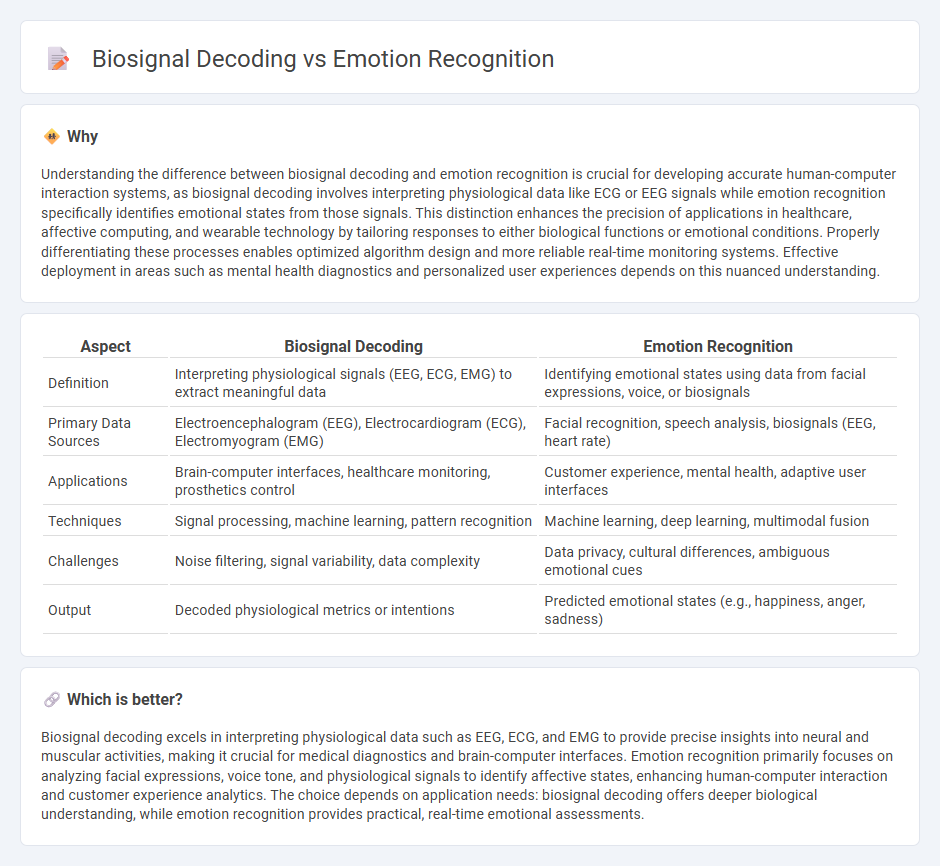
Biosignal decoding involves analyzing physiological signals such as EEG, ECG, and EMG to extract meaningful information about human body functions. Emotion recognition uses these decoded biosignals to identify and interpret emotional states by applying machine learning and neural network algorithms. Explore how advances in biosignal decoding are revolutionizing emotion recognition technologies.
Why it is important
Understanding the difference between biosignal decoding and emotion recognition is crucial for developing accurate human-computer interaction systems, as biosignal decoding involves interpreting physiological data like ECG or EEG signals while emotion recognition specifically identifies emotional states from those signals. This distinction enhances the precision of applications in healthcare, affective computing, and wearable technology by tailoring responses to either biological functions or emotional conditions. Properly differentiating these processes enables optimized algorithm design and more reliable real-time monitoring systems. Effective deployment in areas such as mental health diagnostics and personalized user experiences depends on this nuanced understanding.
Comparison Table
| Aspect | Biosignal Decoding | Emotion Recognition |
|---|---|---|
| Definition | Interpreting physiological signals (EEG, ECG, EMG) to extract meaningful data | Identifying emotional states using data from facial expressions, voice, or biosignals |
| Primary Data Sources | Electroencephalogram (EEG), Electrocardiogram (ECG), Electromyogram (EMG) | Facial recognition, speech analysis, biosignals (EEG, heart rate) |
| Applications | Brain-computer interfaces, healthcare monitoring, prosthetics control | Customer experience, mental health, adaptive user interfaces |
| Techniques | Signal processing, machine learning, pattern recognition | Machine learning, deep learning, multimodal fusion |
| Challenges | Noise filtering, signal variability, data complexity | Data privacy, cultural differences, ambiguous emotional cues |
| Output | Decoded physiological metrics or intentions | Predicted emotional states (e.g., happiness, anger, sadness) |
Which is better?
Biosignal decoding excels in interpreting physiological data such as EEG, ECG, and EMG to provide precise insights into neural and muscular activities, making it crucial for medical diagnostics and brain-computer interfaces. Emotion recognition primarily focuses on analyzing facial expressions, voice tone, and physiological signals to identify affective states, enhancing human-computer interaction and customer experience analytics. The choice depends on application needs: biosignal decoding offers deeper biological understanding, while emotion recognition provides practical, real-time emotional assessments.
Connection
Biosignal decoding involves analyzing physiological data such as EEG, ECG, and EMG to interpret underlying neural activity and bodily functions. Emotion recognition leverages these decoded biosignals to accurately identify emotional states by detecting patterns related to stress, happiness, or anxiety. Advanced machine learning algorithms enhance the precision of emotion recognition systems by processing real-time biosignal data for applications in healthcare, human-computer interaction, and affective computing.
Key Terms
Affective Computing
Emotion recognition in affective computing primarily involves analyzing facial expressions, voice tone, and body language to identify emotional states, while biosignal decoding interprets physiological signals such as EEG, ECG, and galvanic skin response for a deeper understanding of emotions. Biosignal decoding offers more precise and continuous monitoring of affective states by capturing subtle changes in heart rate variability, brain activity, and skin conductance. Explore the latest advancements in affective computing to understand how integrating both methods enhances emotional intelligence in AI systems.
EEG (Electroencephalography)
EEG (Electroencephalography) provides critical insights in both emotion recognition and biosignal decoding by capturing electrical brain activity linked to cognitive and affective states. Emotion recognition leverages EEG patterns such as alpha and beta wave variations to identify feelings like stress or happiness, while biosignal decoding interprets these signals for broader applications including motor imagery and neurological disorder diagnosis. Explore how advanced EEG analysis techniques are transforming the accuracy and scope of both fields for innovative neuroscience applications.
Machine Learning
Emotion recognition leverages machine learning algorithms to interpret facial expressions, voice tonality, and physiological signals for identifying human emotions, while biosignal decoding focuses on analyzing data such as EEG, ECG, and EMG to extract meaningful patterns related to neural or muscular activity. Machine learning models like convolutional neural networks (CNNs) and recurrent neural networks (RNNs) enhance the accuracy of both emotion recognition and biosignal decoding by automatically learning complex features from raw data. Explore more about the intersection of machine learning techniques in advancing emotion recognition and biosignal decoding applications.
Source and External Links
AI Emotion Recognition and Sentiment Analysis - Viso Suite - This webpage discusses AI emotion recognition, focusing on facial emotion detection and automatic sentiment analysis through steps like face detection, image preprocessing, and emotion classification using CNN models.
Emotion Recognition Software - Visage Technologies - This page introduces emotion recognition software that analyzes facial expressions in real-time, aligning with Dr. Paul Ekman's theory of six basic emotions and providing a probability distribution of each emotion.
Emotion Recognition - Wikipedia - This article covers the process of identifying human emotions, discussing various methods and techniques, including machine learning and computer vision, to interpret emotions across different modalities.
 dowidth.com
dowidth.com